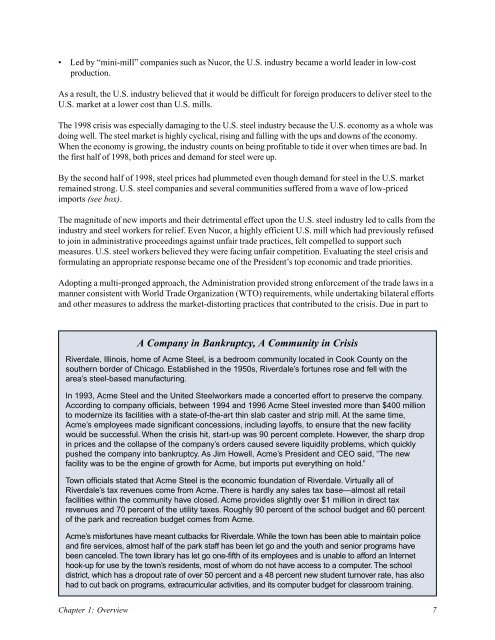Global Steel Trade; Structural Problems and Future Solutions
Global Steel Trade; Structural Problems and Future Solutions
Global Steel Trade; Structural Problems and Future Solutions
Create successful ePaper yourself
Turn your PDF publications into a flip-book with our unique Google optimized e-Paper software.
• Led by “mini-mill” companies such as Nucor, the U.S. industry became a world leader in low-cost<br />
production.<br />
As a result, the U.S. industry believed that it would be difficult for foreign producers to deliver steel to the<br />
U.S. market at a lower cost than U.S. mills.<br />
The 1998 crisis was especially damaging to the U.S. steel industry because the U.S. economy as a whole was<br />
doing well. The steel market is highly cyclical, rising <strong>and</strong> falling with the ups <strong>and</strong> downs of the economy.<br />
When the economy is growing, the industry counts on being profitable to tide it over when times are bad. In<br />
the first half of 1998, both prices <strong>and</strong> dem<strong>and</strong> for steel were up.<br />
By the second half of 1998, steel prices had plummeted even though dem<strong>and</strong> for steel in the U.S. market<br />
remained strong. U.S. steel companies <strong>and</strong> several communities suffered from a wave of low-priced<br />
imports (see box).<br />
The magnitude of new imports <strong>and</strong> their detrimental effect upon the U.S. steel industry led to calls from the<br />
industry <strong>and</strong> steel workers for relief. Even Nucor, a highly efficient U.S. mill which had previously refused<br />
to join in administrative proceedings against unfair trade practices, felt compelled to support such<br />
measures. U.S. steel workers believed they were facing unfair competition. Evaluating the steel crisis <strong>and</strong><br />
formulating an appropriate response became one of the President’s top economic <strong>and</strong> trade priorities.<br />
Adopting a multi-pronged approach, the Administration provided strong enforcement of the trade laws in a<br />
manner consistent with World <strong>Trade</strong> Organization (WTO) requirements, while undertaking bilateral efforts<br />
<strong>and</strong> other measures to address the market-distorting practices that contributed to the crisis. Due in part to<br />
A Company in Bankruptcy, A Community in Crisis<br />
Riverdale, Illinois, home of Acme <strong>Steel</strong>, is a bedroom community located in Cook County on the<br />
southern border of Chicago. Established in the 1950s, Riverdale’s fortunes rose <strong>and</strong> fell with the<br />
area’s steel-based manufacturing.<br />
In 1993, Acme <strong>Steel</strong> <strong>and</strong> the United <strong>Steel</strong>workers made a concerted effort to preserve the company.<br />
According to company officials, between 1994 <strong>and</strong> 1996 Acme <strong>Steel</strong> invested more than $400 million<br />
to modernize its facilities with a state-of-the-art thin slab caster <strong>and</strong> strip mill. At the same time,<br />
Acme’s employees made significant concessions, including layoffs, to ensure that the new facility<br />
would be successful. When the crisis hit, start-up was 90 percent complete. However, the sharp drop<br />
in prices <strong>and</strong> the collapse of the company’s orders caused severe liquidity problems, which quickly<br />
pushed the company into bankruptcy. As Jim Howell, Acme’s President <strong>and</strong> CEO said, “The new<br />
facility was to be the engine of growth for Acme, but imports put everything on hold.”<br />
Town officials stated that Acme <strong>Steel</strong> is the economic foundation of Riverdale. Virtually all of<br />
Riverdale’s tax revenues come from Acme. There is hardly any sales tax base—almost all retail<br />
facilities within the community have closed. Acme provides slightly over $1 million in direct tax<br />
revenues <strong>and</strong> 70 percent of the utility taxes. Roughly 90 percent of the school budget <strong>and</strong> 60 percent<br />
of the park <strong>and</strong> recreation budget comes from Acme.<br />
Acme’s misfortunes have meant cutbacks for Riverdale. While the town has been able to maintain police<br />
<strong>and</strong> fire services, almost half of the park staff has been let go <strong>and</strong> the youth <strong>and</strong> senior programs have<br />
been canceled. The town library has let go one-fifth of its employees <strong>and</strong> is unable to afford an Internet<br />
hook-up for use by the town’s residents, most of whom do not have access to a computer. The school<br />
district, which has a dropout rate of over 50 percent <strong>and</strong> a 48 percent new student turnover rate, has also<br />
had to cut back on programs, extracurricular activities, <strong>and</strong> its computer budget for classroom training.<br />
Chapter 1: Overview 7
















